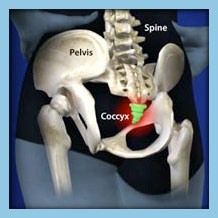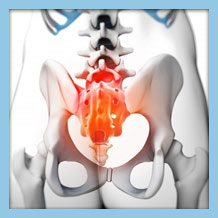

How Do I Know if I Have Coccydynia?
The most common symptom associated with coccydynia is a pain in the coccyx or tailbone region of the spine that worsens with constipation and can be relieved with a bowel movement.
The exact cause of coccydynia is not always known but can be related to stressful childbirth, a traumatic fall, or improper sitting. Coccyx Pain may also rarely be caused by a tumor in the region.
Do you have any of these symptoms and think you may be suffering from coccydynia? We have a quick and easy tool to help gather some information from you to help us determine what your problem is and get you on the road to recovery.
Which Coccydynia Treatment is Right for Me?
Early-stage coccydynia treatment includes sitting on a special pillow with a cutout at the rear of it directly under the coccyx, increased fiber, and stool softeners to ease pain during bowel movements. if the condition progresses, anti-inflammatory medications and pain-relieving drugs may be added to therapy. Only once conservative treatments have been exhausted should surgery be considered.
Orthopedic & Laser Spine Surgery offers many advanced treatment options to treat coccydynia and coccyx pain.
The real question is: What treatment is best to treat your coccydynia? Use our Treatment Match tool to quickly get started in finding the right treatment for you.
Frequently Asked Questions About Coccydynia
How is Coccydynia pain treated for a pregnant woman?
It’s not uncommon for pregnant women to experience tailbone pain. Pain will usually become apparent while sitting, standing, or walking for prolonged periods of time, yet some pregnant women may feel pressure all the time. Generally, pain is caused by the release of relaxin, a hormone produced during pregnancy that loosens ligaments and joints in your pelvic region. The stretching of your pelvic floor, coupled with the weight of a growing fetus, shifts the coccyx out of place.
To effectively treat tailbone pain, spine specialists recommend a range of things you can do for relief. Using a supportive pillow, applying hot and cold packs, and taking over the counter pain medication may help alleviate some pain by reducing muscle tension. If your tailbone pain persists or worsens with bowel movements, seek medical attention from a qualified physician who may provide additional treatment options.
Does walking help Coccydynia?
Pain that courses along the tailbone can extend down the legs. Regularly standing and walking may help ease soreness and pressure in the coccyx. However, if perhaps you have a tailbone fracture or other injury, walking may exacerbate the pain. Depending on what’s causing your pain and the extent of your discomfort, non-strenuous flexibility exercises such as yoga and light stretching may be helpful.
How should I sleep with Coccydynia?
Pain in the Coccyx can make sleeping difficult while sitting and bending can also be uncomfortable. Directly sleeping on your back or stomach may apply even more pressure to the spine. It’s suggested that sleeping on your side and placing a pillow between your knees is the best way to ease discomfort. Again, what works for one person may not work for you. An experienced spine specialist can administer an array of alternative and supportive medical treatments that may rid your pain.
